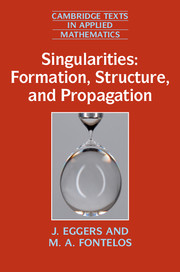Book contents
- Frontmatter
- Dedication
- Contents
- Preface
- PART I SETTING THE SCENE
- PART II FORMATION OF SINGULARITIES
- 7 Drop breakup
- 8 A numerical example: drop pinch-off
- 9 Slow convergence
- 10 Continuation
- PART III PERSISTENT SINGULARITIES: PROPAGATION
- Appendix A Vector calculus
- Appendix B Index notation and the summation convention
- Appendix C Dimensional analysis
- References
- Index
8 - A numerical example: drop pinch-off
from PART II - FORMATION OF SINGULARITIES
Published online by Cambridge University Press: 05 September 2015
- Frontmatter
- Dedication
- Contents
- Preface
- PART I SETTING THE SCENE
- PART II FORMATION OF SINGULARITIES
- 7 Drop breakup
- 8 A numerical example: drop pinch-off
- 9 Slow convergence
- 10 Continuation
- PART III PERSISTENT SINGULARITIES: PROPAGATION
- Appendix A Vector calculus
- Appendix B Index notation and the summation convention
- Appendix C Dimensional analysis
- References
- Index
Summary
Numerical methods play an important role in our understanding of singularities. Simulations often provide crucial pointers to the local structure of a singularity, and they reveal which physical effects dominate near a singularity. In addition, the analytical descriptions that we are able to obtain encompass only the local structure of the solution. One often has to rely on numerics in order to capture how local singular solutions are connected on the global scale.
Regrettably, the development of numerical codes is often considered a pursuit best left to the specialist. Our aim is to highlight some of the fundamental ideas that go into the numerical description of singular behavior. As an example, we take the description of a capillary bridge of liquid collapsing under gravity (see Fig. 8.1), which we will describe in some technical detail. Two aspects are of particular importance:
Stability Solutions which are close to singular involve a wide range of time scales. As a result, great demands are placed on the stability of the numerical scheme being used. This issue is addressed by using so-called implicit numerical schemes.
Adaptability As the singularity is approached, the solution evolves on smaller and smaller length and time scales. It is crucial that the numerical scheme adapts to these changes, by adjusting the time step and by refining the computational grid in a small region around the singularity.
Finite-difference scheme
A liquid drop is held between two endplates of radius r0 which are a distance L apart; cf. Example 6.4 in Section 6.2. We solve equations (6.59), (6.57) on a grid zi, i= 1, . . ., k, which divides up the computational domain; see Fig. 8.2. Since the total length of the bridge is L, we have z1 = 0 and zk = L. The grid spacing between two points is denoted as below we discuss in more detail how is chosen to represent a given problem accurately. The radius h(z) is represented by its values on this grid.
Information
- Type
- Chapter
- Information
- Singularities: Formation, Structure, and Propagation , pp. 186 - 206Publisher: Cambridge University PressPrint publication year: 2015
